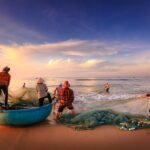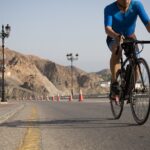Recent Posts
Skiing Vs Snowboarding: Differences
25th July 2023Best Tips For Fishing: Beginners and Intermediate Fishers
25th July 2023Cycling Safety Measures and Best Practices
16th July 2023Benefits Of Cycling For Physical and Mental Health
15th July 2023Best Kayak for Camping and Fishing

Are you looking for the best kayak for camping and fishing? Camping and fishing are two fun and amazing events many often involve, and kayaking is another fun hobby. They all offer you a sense of adventure and freedom.
So, the fun is limitless when camping and fishing are combined with kayaking. Whether you are kayaking on a lake, river, or coastline, you can be sure of the joy it will bring.
But how can you get the best kayak for camping and fishing? Follow along as we expose you to the secret.
Best Kayak for Camping and Fishing
| PRODUCT NAME | GO TO |
|---|---|
| 1. Intex Explorer K2 Kayak | CHECK ON AMAZON |
| 2. Intex Challenger K2 Kayak | CHECK ON AMAZON |
| 3. Sundolphin 13.5 Foot Tandem Kayak | CHECK ON AMAZON |
| 4. Sundolphin Aruba SS 8-Foot sit-in-kayaks | CHECK ON AMAZON |
| 5. Ztotop 2-person inflatable kayak | CHECK ON AMAZON |
Criteria for Selecting Best Kayak for Camping and Fishing
Here are some important criteria that will help you make the reasonable and right decision about the right kayak for your camping and fishing;
- Storage: the available space for storage is important. You need space for keeping your camping equipment, and for keeping the fish, you hunt. Get large tank well and watertight kayak.
- Maximum load: ensure you check the maximum load capacity for the kayak. This will help prevent stretching the kayak to its limit.
- Comfort: kayak camping and fishing can be on for several days. If you are not comfortable, camping and fishing won’t be successful. The seats should be adjustable and come with footplates for comfort.
- Performance: this is influenced by the location it will be used in, whether calm water or turbulent one.
5 Best Kayaks for Camping and Fishing
1. Intex Explorer K2 Kayak
This is an inflatable kayak that is perfect for fishing and camping. It is designed to carry just two people and is comfortable for everyone.
It includes an adjustable inflatable seat with rest, and a cockpit is designed our comfort while fis,hing, and space to keep your catch.
The kayak has a dimension of 20 by 36 by 123 inches. It has an overall weight capacity of 400 pounds. The kayak offers directional stability thanks to the removable skeg of the kayak.
The bright yellow color of this kayak help provides increased visibility while fishing.
2. Intex Challenger K2 Kayak
This is another 2-person inflatable kayak that is sporty and fun to camp and fish in; it comes with a streamlined design, making paddling easier on this kayak.
It comes with an 86 inches aluminum paddle and an Intex high output pump, making inflation and deflation easier. The rugged kayak has super tough vinyl that is puncture and UV-damage-resistant.
It has an overall dimension of 30 by 15 by 138 inches. The kayak has a general weight capacity of 400 pounds. It has a bright yellow color and a sporty design that makes it visible in the water.
3. Sundolphin 13.5 Foot Tandem Kayak
This bigger kayak can comfortably accommodate 2 to 3 people when going on the fishing game. It is best for all types of camping events.
The kayak is also perfect for fishing, thanks to the three covered storage compartments where you can keep your fishing equipment and fish you found while hunting.
The kayak has an onboard shock cord deck rigging and an adjustable seat with comfortable back support. The Sundolphin 13.5 Foot Tandem Kayak is indeed the perfect kayak for fishing, and it has an overall dimension of 163 by 34 by 17 inches.
4. Sundolphin Aruba SS 8-Foot sit-in-kayaks
This kayak is great for campaigning and fishing on rivers, lakes, and coastlines. It is perfect for one or two persons and has enough space to accommodate your fishing gear.
The kayak has an adjustable padded seat back and a lightweight design, making it easier to carry about. The storage compartment is sufficient and large enough to make camping fun and enjoyable.
The kayak also has a recessed drink holder, which makes it perfect for all activities. Family fun can be enjoyed when making use of this kayak.
5. Ztotop 2-person inflatable kayak
This kayak has an overall length of 138 inches, approximately 3.5m. It has two aluminum oars of 9.2 inches in length. It also has a maximum load capacity of 400 lbs.
It is made from durable, heavy-duty, puncture-resistant material and is safe on the water. The kayak can easily be inflated and deflated because of the Boston valves of the kayak.
The kayak has two adjustable seats and a backrest, making it comfortable while fishing or camping. The air chamber of the kayak is separate from each other, which makes it safer to use as the other one can work when one is damaged.
What are Fishing kayaks?
Fishing kayaks offer many features. They often have flush-mount brackets or adjustable rod holders.
They have storage spaces designed for your fishing amenities. Some have raised seats for better comfort for a long day on the water than sea kayaking, recreational kayaking, or white-water kayaking.
The fishing kayak favors increased stability, even for the fishermen standing in their boats.
How to choose your fishing kayak?
Firstly, you have to define your needs. Choosing a kayak that matches the environment where you plan to fish is essential, and that best meets your requirements.
Since the perfect kayak for all types of water bodies and ideal for all situations and conditions does not exist, it is imperative to ask yourself the following questions.
On which water plan do we plan to fish? What is the distance to go fishing, and is there portage to do? How much equipment and material to transport?
Types of fishing kayak
Two fishing kayaks are semi-closed and open, commonly called “sit-in” and “sit-on-top.” Each has its advantages and disadvantages.
The semi-closed kayak has a closed deck. The kayaker, once seated, his legs inside the kayak. This kind of boat offers protection against water and keeps you dry. This is an advantage, especially if you plan to fish in cold water early in the season. This type of kayak also allows for better stability.
A semi-closed kayak is often more substantial than an open kayak. Sitting down lowers the center of gravity. On the other hand, the closed bridge makes it more challenging to get in and out of it.
The open kayak, as its name suggests, has an open deck. It is comfortable to get on and off. Another benefit to this kind of kayak is its virtually unsinkable design.
Most anglers prefer the open model (sit on top) because it allows adding accessories easily. It is also the most often recommended model.
The dimensions and characteristics of the kayak
Width – A full kayak is more stable than a narrow one. For fishing, we promote increased stability. A larger kayak allows even fishers to fish standing.
A narrow kayak is more comfortable to propel because it provides less resistance to water. It is faster and offers a better heading. A larger kayak also provides more space for equipment and luggage.
Length
A short kayak has the advantage of being lighter and easier to maneuver. This is the ideal type of boat for small water bodies with many obstacles. A long kayak is faster than a court and holds the course better.
This is the kind of boat that is more efficient in open water and allows you to travel great distances faster.
Depth –
Depth is the distance from the top to the bottom of the kayak. The deeper a kayak is, the less water it lets in. It also provides better load capacity.
On the contrary, it possesses the disadvantage of having a bigger grip on the wind. A shallow kayak offers less wind resistance but has a lower load capacity, making it easier to get in the water.
The lap
The difference in height between the points and the center of a boat is called the lap. The waves raise a kayak with a stern (the back) and a bow (the front) more efficiently.
Also, the more the tread is pronounced, the quicker the kayak turns quickly. Conversely, if the lap is weak, the kayak will run harder but hold the course better.
Weight
Weight plays an important role when it comes to porters. Too heavy a kayak will discourage the most motivated fisherman, just at the thought of having to put it on the car. It makes all the difference between an easy fishing excursion and a most exhausting expedition.
Color
One should choose the color of one’s kayak according to safety and opt for a bright color like orange, yellow, or red. Some amateurs will choose a camouflage pattern, while others will opt for colors depending on the environment or trends, the colors in fashion. Since color does not play an essential role in the success of a fishing trip, safety should always be promoted.
Mandatory Equipment
The necessary equipment varies according to the size and type of boat, the time of day, and the body of water where you sail. There should be a minimum of accessories on board: a PFD, a whistle, a buoyant heaving line of at least 15 meters lengthy, a scoop, and a flashlight.
Essential equipment
Kayaking is not just a kayak and a fishing rod! To move, it will take a paddle. Many elements can be very useful or even essential to increase the safety of the fisherman, the boat, or the equipment. A paddle leash is also highly recommended. This stretchy safety cord prevents the paddle from falling into the water and disappearing away with the current, leaving the kayaker without any means of propulsion. Bringing accessories such as a first aid kit, stabilizers, a paddle balloon, and a waterproof bag or suitcase may be worthwhile.
Comfort and convenience
The essential accessory of a fishing kayak is undoubtedly the seat. A raised, full, and comfortable position will make all the difference when spending long days on the water. The fisherman will also have the choice of a kayak with or without a rudder. This element makes it easier to stay on course. A handy option if you have great distances to travel. The optional accessories are numerous, and their utility is more varied. According to needs and desires, the fisherman will be able to equip his kayak with a camera or video camera stand, a tray to prepare the baits, a small anchor, a glass holder or a cup holder, a GPS, fish finder, sonar mount, paddle attachment system, mounting rails, a suction pad, and more.
Recent Posts
Techniques and Best Practices for Anglers
21st November 2023Hiking Vs Trekking: Differences and Similarities
12th August 2023How to Lose Weight by Cycling
12th August 2023How to Choose Skis for Beginners
12th August 2023Related Articles
Techniques and Best Practices for Anglers
For fishing enthusiasts, the process of angling goes beyond a simple hobby....
By O. Johnson Taiwo21st November 2023Hiking Vs Trekking: Differences and Similarities
Hiking and trekking are two outdoor activities that revolve around walking in...
By Fortunatus Adunola12th August 2023How to Lose Weight by Cycling
Cycling is a fantastic exercise that is fun and can be enjoyed...
By O. Johnson Taiwo12th August 2023How to Choose Skis for Beginners
Choosing the right skis is essential for beginners embarking on their skiing...
By Fortunatus Adunola12th August 2023



















